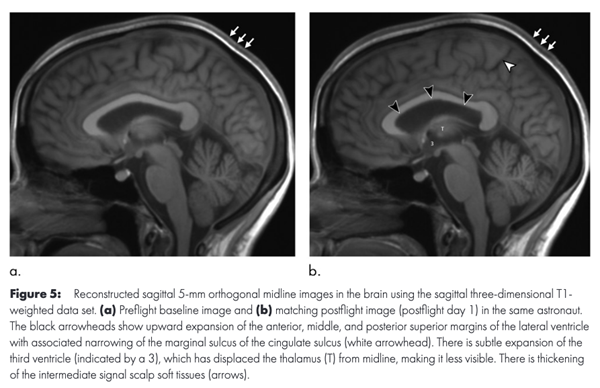The hazards of long-term spaceflight – Astronomy Magazine
Comparison between preflight and postflight MRI scans revealed small but significant changes occur in the brains of astronauts during long-term spaceflights.
Radiology 2020; 00:1–9 (“Intracranial Effects of Microgravity: A Prospective Longitudinal MRI Study”)
First, the overall volume of the astronauts’ brains increased (particularly the white matter), as did the volume of their cerebrospinal fluid (CSF), the liquid that bathes our brains and spinal cords. Both increases were on the order of about 2 percent.
The team also noted more CSF flowing through the astronauts’ brains postflight. Likewise, the volume of their ventricles, which are the cavities that carry CSF through the brain, also increased. These increases in both volume and flow might be small, but the researchers think they’re still meaningful. And, what’s more, the changes appeared to last through the entire duration of the postflight study.
Another intriguing finding was that for six of the 11 astronauts, the sizes and shapes of their pituitary glands — which serve as a kind of “master controller” for a variety of hormones used throughout the body — also changed. According to the researchers, the morphed shape of the pituitary glands may indicate an increase in the pressure of fluid within the brain. And that increased fluid pressure, they say, may be part of the root cause of SANS.
However, Kramer admits to Astronomy that the root cause of SANS still may be more complex than just increased intracranial pressure. And that’s partly because astronauts do not experience the same range of symptoms as people with increased intracranial pressure on Earth. Furthermore, the pituitary gland also resides next to the optic nerve, which carries inputs from the eyes to the brain. So, it’s possible that the pituitary gland presses on the optic nerve more than usual during spaceflight, partially causing astronauts to experience the visual symptoms of SANS.
With this work, scientists have taken yet another small step toward understanding how spaceflight impacts the human body. And though the study of humans in space began more than half a century ago, it will surely continue for as long as we strive to reach Mars and beyond. The long-term changes found in this new research may lead to structural changes in the eyes of astronauts, a potential cause of SANS. In other words, when you’re in space long enough, your eyes may suffer as the brain grows larger.
But just how much would such changes impact a long-term mission to another planet?






